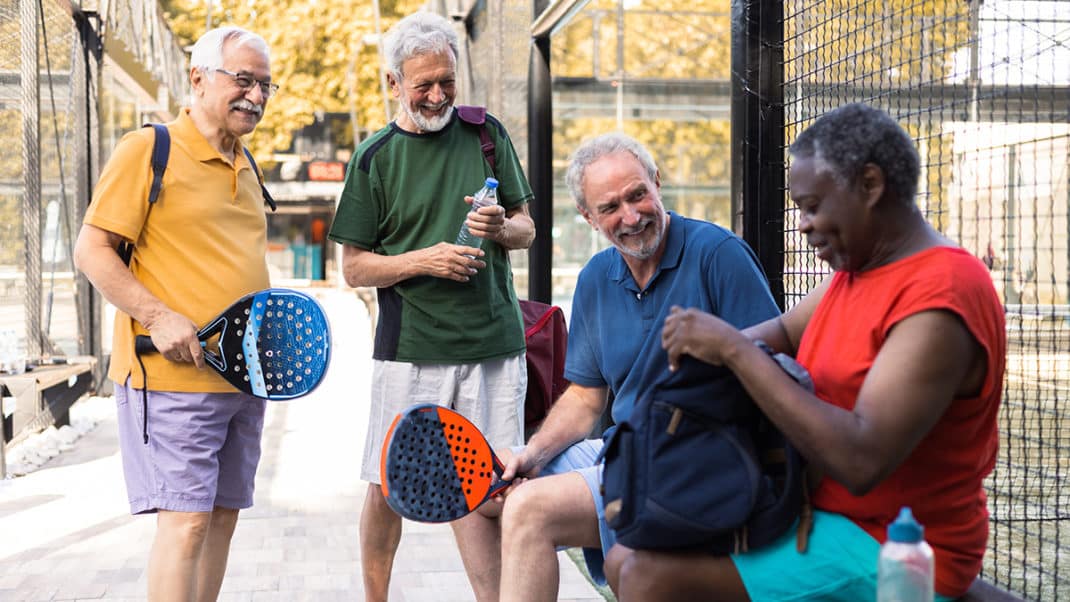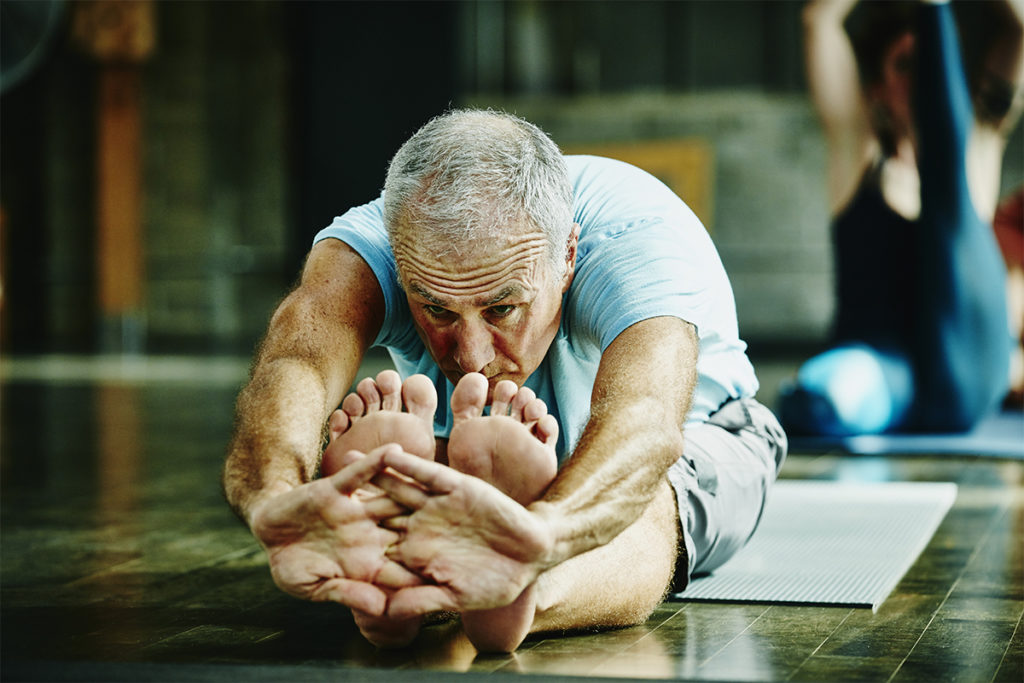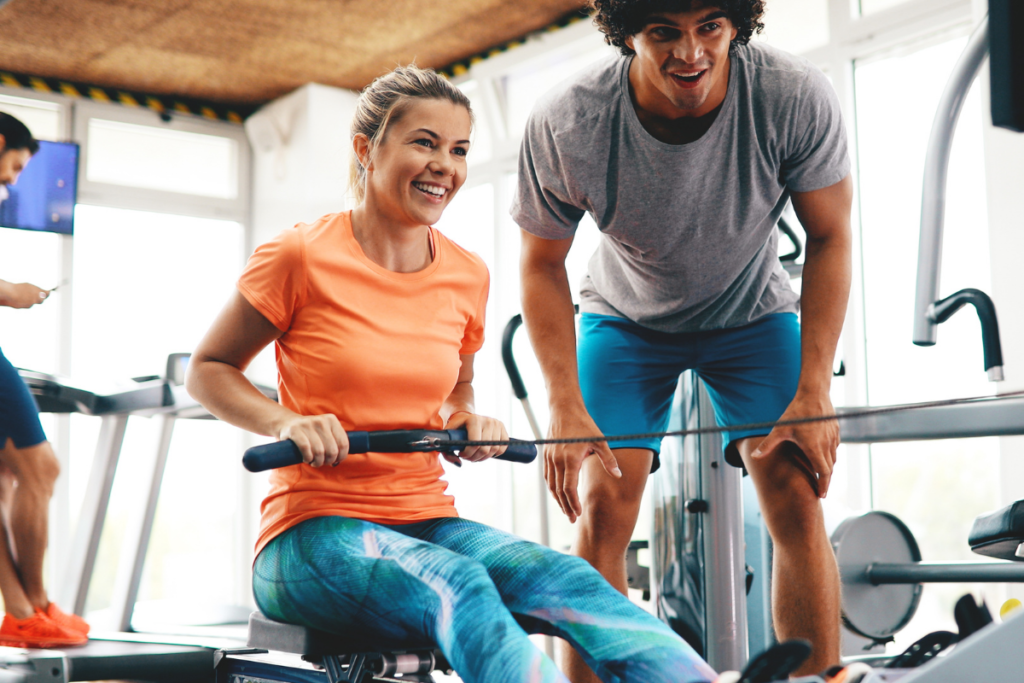3 Rowing Workouts to Boost Strength, Endurance, and Aerobic Capacity
Don't forget about the rowing machine—it's a perfect tool to help clients improve all areas of fitness.

Rowing has been a competitive sport for hundreds of years (and an official Olympic event since the modern Games began), and it consistently produces some of the world's fittest athletes (Steinacker 1993).
Formats spanning Indo-Row®, Orangetheory® Fitness and CrossFit® all include rowing programming, but we tend not to use it widely for our general fitness clients. Although few fitness professionals can say they have been in a racing shell with crew and coxswain, we can teach our clients to correctly use the rowing machine at their local gym to reach new levels of fitness.
Like any competitive sport, rowing can be intense, with a high risk of injury, but the sport is still considered "nonimpact," making it—for most clients—a great training tool at lower intensity levels, regardless of musculoskeletal limitations. The rowing ergometer (affectionately called the "erg" in the rowing community) is like any fitness machine: If clients use it properly, there is little risk of injury.
As long as rowing form is correct and efficient, clients of all ages, sizes and abilities will enjoy better cardiovascular and muscular function from rowing regularly. So when clients tire of the same old "glute burner" selection on the elliptical, the indoor rowing machine can provide a great new challenge.
The Science of Rowing
Competitive rowers have registered some of the largest maximum oxygen uptake (VO2max) values ever recorded, because the sport requires a large mass of body muscle (Steinacker 1993). Although most of our general fitness clients won't need a VO2max in the 65–70 milliliters/kilogram of body weight/minute range, they can still row their way to a higher VO2max, boosting energy levels and improving overall cardiovascular function.
Like other effective cardiovascular training protocols, rowing increases mitochondrial density and capillary count over time. Row training also increases the size of both fast- and slow-twitch muscle fibers (Steinacker 1993).
Rowing is a good option for clients who seek hypertrophy but feel that cardio holds back their gains in muscle mass. Erg training will add muscle while providing the cardio they otherwise might not get. Furthermore, rowing can be a great way for clients to build mental fortitude and stay motivated.
Rowing Stats to Watch
While seated on the erg, rowers can see their split time (time it takes to row 500 meters) and/or watts (power output), which can really challenge them to achieve new levels of fitness and push past preconceptions about their physical abilities. As they repeat some of the workouts in this article, clients will see their progress over a longer period of time, which can be an effective extrinsic motivator.
For anyone looking to improve metabolic markers of chronic disease such as glucose tolerance, insulin sensitivity and lipid profiles, rowing can also offer positive changes in body composition, as noted in several studies. One from the International Spinal Cord Society found a significant decrease in fat mass and a notable increase in lean mass in patients with different forms of spinal-cord injuries (a rowing machine with functional electrical stimulation was used) (Kim et al. 2014).
Basic Biomechanics
The biomechanics of rowing are pretty simple—the activity uses just about every body part! Approximately 70% of our muscle mass is used while rowing, according to several researchers (Steinacker 1993; Ogurkowska et al. 2015; Hagerman 2010). Beginning from the ankles and going all the way to the wrists and fingers, nearly every joint in our body goes through some degree of flexion and/or extension.
Forget the notion that rowing is all upper body. The lower body, specifically the quadriceps group, does a tremendous amount of work on the "drive" phase of the stroke (as the rower pushes away from the foot stretchers). The upper body and back are engaged just at the end of the stroke. The hamstrings are also very important during the recovery phase of the stroke, as they work to apply the brakes, or eccentrically slow the body, when needed to allow a controlled recovery up the slide. This is why flexibility can be improved through rowing, especially within the posterior chain.
Core stability can also improve through rowing. While core musculature maintains trunk position as the hips swing open and closed, force transfers through the feet, increasing stroke power and saving the lower back from injury.
Practical Rowing Workouts
Research tells us that rowing is a great way to safely improve cardiovascular fitness, muscular strength and endurance, flexibility and body composition. Because these are the five major components of fitness, rowing can be the perfect tool for many people to reach their goals. Using the three workouts below, your clients will improve all these areas of fitness by working through the three major energy systems: aerobic, glycolytic and anaerobic.
1. Aerobic Workout (10-9-8-7)
The aerobic system is always working in the sport of rowing. A 2,000 m race takes roughly 5:30–7:30 minutes, depending on the racing crew and the type of shell, so it's important to have an efficient aerobic system.
For a general fitness client who is training for life and not the Olympics, a stronger aerobic system makes it easier to take care of kids, work around the house, use the stairs at work, and race from one meeting to the next without running out of breath.
A great aerobic system workout is the 10-9-8-7, which my college coach made our team do as a periodic fitness test throughout the year. Although I loathed it then, I appreciate the physiological benefits today (Thanks, Coach Sweeney!).
To do the 10-9-8-7, set the erg timer or your watch for 10 minutes. Be sure your client wears a heart rate monitor so you can track improvements over time. The goal of this workout is to improve heart rate recovery when working in the aerobic zone. Use an open-rate row (stroke rate as high or low as the client prefers) for 10 minutes, recording heart rate and total meters covered. Then rest for 10 minutes (this seems long, but it will come in handy later, and your client will wish it were longer).
Before rowing for 9 minutes on the next set, record heart rate recovery. Do the 9-minute set at an open rate again, tracking heart rate and total meters at the end. Rest for 10 more minutes. Repeat this process for 8- and 7-minute sets, making sure you gather heart rate recovery data.
Again, the goal is to improve cardiovascular endurance by improving the body's ability to recover between sets. This translates well to a 2,000 m rowing race and is a great way for general fitness clients to build endurance. The entire workout takes 64 minutes.
2. Glycolytic System Workout (500 M Repeats)
The glycolytic system improves muscle's capacity to buffer exercise byproducts (neutralize acid buildup), which makes this system essential for rowing. In a rowing sprint race, a significant amount of lactic acid builds up, creating an incredible physical and mental challenge. In real life, the glycolytic system works for us when we are rushing around in a 2-minute family drill (picking up toys, doing laundry and cleaning up aft er dinner!) or when we're literally running late to soccer practice.
For the 500 m repeats, allow your client to warm up for 5–10 minutes. When the client is ready, set the erg to count backward from 500 m (using the setting and timer). Set the rest time between the 500 m repeats for a predetermined length of time, depending on fitness level. The newer the client is to fitness, the more rest he or she will likely need.
At an open rate (using as many strokes per minute as feels comfortable; typical rowing races are done at 30–40 strokes per minute), ask your client to hold a split time for the 500 m. The goal will be to maintain that time (split for 500 m) for the entire set.
Start with a rest time of at least twice as long as it takes a client to finish the set. For example, if it takes 3 minutes to finish 500 m, allow 6 minutes of rest. Repeat the 500 m four times, recording average split time and overall completion time. Over time, buffering capacity improves and clients therefore need less rest to maintain a low split time.
In the glycolytic system, providing a work-to-rest ratio of 1:2 is sufficient for recovery, but you can adjust based on the client's fitness level.
3. Anaerobic Workout
Time to sprint! The anaerobic system supplies energy for just 6–10 seconds, so these sprints will take place between easier sets.
Start your client with a 5-minute warm-up. Ensure that the heart rate stays low (Zone 1). Rest is crucial for complete recovery of the anaerobic system, so this workout will include active recovery so that the client doesn't have to go back and forth from the machine.
Begin with a 5-minute row at a stroke rate of less than 20 strokes per minute (15–18 is usually a good pace). At the 5-minute mark, the client will sprint for no more than 20 seconds as fast as possible with an open stroke rate. Watching the timer, have the client row for another 4 minutes, then repeat the 20-second sprint. The client will row for 3 minutes, sprint for 20 seconds and then repeat at the 2- and the 1-minute markers.
In total, the client will do only 80 seconds of hard work (20 × 4) with 15 minutes of easy rowing (5 + 4 + 3 + 2 + 1 = 15). Feel free to repeat this set up to three more times for a 60-minute workout.
These are some of the major mistakes that occur when using a rowing ergometer:
- not engaging the core while pushing with the legs, which creates a "shooting" of the hips
- allowing the back to round and shoulders to slump forward, which places undue stress on the lower back and shoulders
- allowing the knees to bend first on the recovery instead of letting the body swing back over the legs, which causes a timing issue for the tension chain
Contraindications
- If a client has a pre-existing condition such as a lower-back injury, a doctor or physical therapist should be consulted before adding the erg to the client's routine. Rowing does place additional load on areas of the lumbar spine (Ogurkowska et al. 2015).
- During the catch-and-pull phase of the stroke, when breathing correctly the client will perform a short Valsalva maneuver to maintain stability in the trunk as the legs extend. Just as in strength training, this will increase the client's blood pressure (Hartwell, Volberding & Brennan 2015), so advise clients with hypertension to seek medical clearance before participating in a rowing program.
- Sit tall at the "catch," with arms straight, spine erect, knees bent and ankles dorsiflexed. Engage the lats to set the shoulders, and recruit the core muscles to protect the lower back.
- "Drive" by pushing with the legs first, maintaining engagement in the trunk. When the legs are fulling extended, hinge open at the hips and lean the trunk back at approximately 45 degrees—backward from 90 degrees seated upright (Ogurkowska et al. 2015). Last, pull with the arms, bringing the handle into the trunk between the bellybutton and the nipples (exactly where will depend on trunk and arm lengths).
- To "recover," allow the arms to extend first; hinge at the hips, bringing the trunk over the legs; then return the catch by bending the knees last.
References
Hagerman, F. 2010. An update of rowing physiology. Department of Biomedical Sciences, Ohio University. Accessed Nov. 10, 2016. http://archive.usrowing.org/docs/default-source/resource-library/8A-6.pdf.
Hartwell, M.S., Volberding, J.L., & Brennan, D.K. 2015. Cardiovascular drift while rowing on an ergometer. Journal of Exercise Physiology Online, 18 (2), 95-102.
Kim, D.I., et al. 2014. A six-week motor-driven functional electronic stimulation rowing program improves muscle strength and body composition in people with spinal cord injury: A pilot study. Spinal Cord, 52 (8), 621-24.
Ogurkowska, M., et al. 2015. Biomechanical characteristics of rowing. Trends in Sports Sciences, 2 (22), 61-69.
Steinacker, J.M. 1993. Physiological aspects of training in rowing. International Journal of Sports Medicine, 14 (Suppl. 1), S3-S10.





